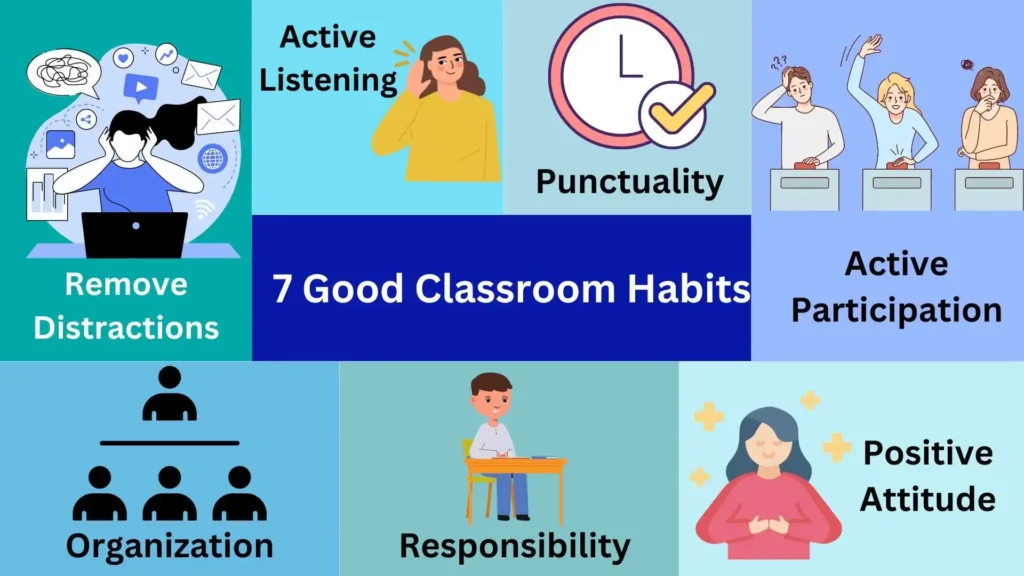Why do some students perform better than others in school? Although there isn’t a single answer, it often boils down to this: They have acquired good classroom habits that they consistently practice.
Good classroom habits serve as the foundation for academic achievement, personal growth, and long-term success. They enhance performance and create a positive learning atmosphere for everyone.
As you practice these habits, you will become a happier, healthier, and more successful student.
Table of Contents
What are Good Classroom Habits?
Good classroom habits refer to positive behaviors and practices that students adopt to enhance their learning experience and contribute to a productive and supportive classroom environment.
These habits encompass a range of skills and attitudes that promote academic success, personal growth, and positive interactions with peers and teachers
7 Good Classroom Habits for Student
The top 7 good classroom habits are the following.

1. Remove Distractions
In today’s digital age, where smartphones, social media, and other external stimuli compete for attention, mastering the skill of eliminating distractions is more critical than ever.
When you remove distractions, you create an environment conducive to concentration and engagement. By reducing distractions, such as monitoring social media notifications or chatting with classmates, you can devote your full attention to the lesson at hand.
This allows you to absorb information more effectively, participate actively in class discussions, and ultimately achieve better academic outcomes.
As Maya Angelou stated, “You can’t use up creativity. The more you use, the more you have.”
Removing distractions promotes a sense of discipline and self-control among students. It teaches them to prioritize their academic responsibilities and avoid the desire to yield to distraction. Similarly, you can also develop good study habits by removing distractions.
How Can You Remove Distractions in the Classroom?
- Set clear guidelines for classroom behavior.
- Implement a “device-free zone” during lectures or group activities to encourage focus and attention.
- Arrange seating to minimize distractions and promote engagement.
- Incorporate short breaks into lessons to prevent fatigue and boredom.
- Engage yourself in interactive learning activities that require your active involvement.
2. Active Listening
Active listening is the cornerstone of meaningful dialogue and comprehension. Developing the habit of active listening empowers you to engage deeply with your course material, collaborate effectively with peers, and glean valuable insights from your teachers.
As novelist Ernest Hemingway once remarked, “I like to listen. I have learned a great deal from listening carefully. Most people never listen.”
Active listening requires paying full attention to the speaker, keeping eye contact, and providing insightful responses. By embracing active listening as a good classroom habit, you can enrich your learning experiences and forge stronger connections with your peers and instructors.
As American poet Robert Frost eloquently put it, “The ear is the only true writer and the only true reader.”
How to be an Active Listener?
- Give full Attention: Focus entirely on the speaker without distractions, such as checking your phone or thinking about other tasks.
- Maintain eye contact: Show that you are engaged and attentive by making regular eye contact with the speaker.
- Use nonverbal cues: Demonstrate your interest and understanding through nods, facial expressions, and gestures that indicate you are listening.
- Avoid interrupting: Even if you have questions or remarks, let the speaker finish their point without intervening.
- Ask clarifying questions: Ask for clarification or more details to make sure you fully and accurately comprehend the speaker’s message.
3. Punctuality
Time is a precious commodity, and punctuality is a sign of respect for oneself and others. Arriving on time for class demonstrates responsibility, reliability, and a commitment to academic excellence.
As renowned author Benjamin Franklin famously wrote, “Lost time is never found again.”
Punctuality encompasses more than just showing up on time; it also involves being prepared and ready to engage in learning activities.
By cultivating the habit of punctuality, you can maximize your learning opportunities, contribute meaningfully to class discussions, and set a positive example for your peers.
Poet Emily Dickinson says, “Forever is composed of Nows.”
How can you be punctual in class?
- Plan: Prepare for class in advance by organizing your materials, such as textbooks, notebooks, and assignments, the night before. This helps ensure that you’re ready to leave for class on time in the morning.
- Set alarms or reminders: Use alarms or reminders on your phone or other devices to alert you when it’s time to leave for class. Set multiple reminders if necessary to account for potential distractions.
- Leave early: Give yourself extra time to reach the classroom by leaving early. Consider probable delays, such as traffic or congested hallways, to ensure that you arrive on time or even a few minutes ahead.
- Develop a schedule: Create a consistent pattern and organization, just like successful people’s habits for getting ready and going to class. Stick to this routine to build habits that promote punctuality and minimize the risk of being late.
- Prioritize punctuality: Recognize the importance of punctuality and the impact it has on your academic success and the learning environment. Make punctuality a priority and commit to arriving on time for every class session.
4. Active Participation
Active participation is a good classroom habit and a cornerstone of a successful learning experience. When students actively engage in classroom discussions, group activities, and hands-on learning experiences, They gain a deeper comprehension of the material and sharpen their critical thinking abilities.
Active participation encourages students to tap into their creativity and express their ideas, perspectives, and opinions. It promotes collaboration, communication, and a sense of ownership over their learning journey.
How to be an active participant?
- Listen attentively: Pay close attention to what the teacher and your classmates are saying.
- Ask questions: If you require any clarification, don’t be afraid to ask questions. Asking questions not only clarifies your understanding but also encourages discussion and deeper learning.
- Contribute to discussions: Share your thoughts, ideas, and opinions during class discussions. Feel free to express yourself and contribute to the conversation.
- Participate in group activities: Engage actively in group activities and projects. Collaborate with your peers, offer input, and work together to achieve common goals.
- Take notes: Take thorough and organized notes during class. Writing down key points and important information helps reinforce your understanding and retention of the material. You can also develop reading habits for your class materials by taking notes.
5. Organization
Organization is key to academic success. Well-organized students can efficiently manage their time, remember assignments and due dates, and access resources.
A well-organized student is better equipped to stay focused, meet academic expectations, and achieve their goals.
As Benjamin Franklin famously said, “For every minute spent in organizing, an hour is earned.”
Organizational skills save time and reduce stress, allowing students to devote more energy to learning and mastering course material. By cultivating good organizational habits, students set themselves up for success both inside and outside the classroom.
How to be organized in the classroom?
- Use a planner: Keep a planner or digital calendar to track assignments, deadlines, and important dates.
- Keep materials tidy: Organize notebooks, textbooks, and supplies neatly in a backpack or desk to minimize clutter.
- Prioritize tasks: Determine which tasks are the most critical and prioritize them to keep on top of your duties.
- Set up a system: Develop a system for organizing papers, such as using folders or color-coding, to make it easy to find and manage class materials.
- Review regularly: Take time to review your planner and materials regularly to ensure everything is up-to-date and in order.
6. Responsibility
Responsibility is a good classroom habit that empowers you to take ownership of your actions, learning, and academic success.
When you demonstrate responsibility, you show accountability for your behavior, assignments, and contributions to the learning environment.
As J.K. Rowling once said, “It is our choices that show what we truly are, far more than our abilities.”
Taking responsibility for one’s actions reflects integrity and maturity, fostering a culture of trust and respect in the classroom.
How can you be responsible in the classroom?
- On-time assignments: Submit work on time. It shows responsibility and commitment.
- Active participation: Engage in discussions and activities to take responsibility for learning.
- Respect rules: Follow the rules of the class. It demonstrates consideration for others.
- Material care: Treat resources with care to maintain classroom organization.
- Seeking help: Ask questions when needed. It shows responsibility for understanding and progress.
7. Positive Attitude
Maintaining a positive attitude is essential for creating a supportive and inclusive learning environment in the classroom. A positive outlook on life enables one to face obstacles with perseverance, optimism, and a growth mindset.
As Helen Keller famously said, “Keep your face to the sunshine, and you cannot see a shadow.”
A positive attitude shines through even in difficult times, inspiring others and fostering a sense of community and camaraderie in the classroom.
How to show a positive attitude in the classroom?
- Be optimistic: Embrace difficulties as opportunities for growth and learning. Develop an optimistic mind, like the habits of happy people.
- Encourage classmates: Encourage and support fellow students in order to create a happy and encouraging learning atmosphere.
- Participate enthusiastically: Engage in class activities and discussions with enthusiasm and energy.
- Have a growth mindset: Have faith in your capacity to grow and achieve with hard work and persistence.
- Show gratitude: Express appreciation for opportunities to learn and collaborate with others in the classroom.
Why are Good Classroom Habits Important for students?
Good classroom habits are crucial for students as they provide a foundation for success both academically and personally. These habits help students stay organized, focused, and actively participate in their learning, resulting in better academic achievement and overall well-being.
Final Thoughts
Developing good classroom habits is essential for creating a constructive and effective classroom setting where students can thrive academically and personally.
By practicing responsibility, maintaining a positive attitude, and actively participating in class, you not only improve your individual learning experience but also contribute to the success of the entire classroom community.
As educators and students alike embrace these habits, they cultivate a culture of excellence, respect, and achievement that lays the foundation for lifelong success.




